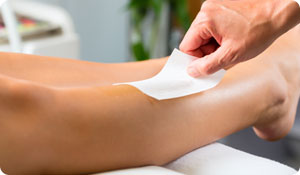
Women have included vaginal grooming techniques in their beauty routines for centuries, but never more so than now. In fact, hair removal and "landscaping" is a huge industry that includes at-home, salon, medi-spa, and medical treatments. But which options are safe and which ought to be avoided?
It's important to say right off the bat that it's not necessary for any health purposes to remove pubic hair. Nor is it healthy to use feminine hygiene products like douches, sprays, or deodorants designed to clean the vagina or change the way it smells. Plain old soap and water is all anyone needs and in fact, anything else can lead to (or mask) infections, rashes, and irritation.
Some women prefer having less pubic hair or want to make sure nothing shows when they're wearing a swimsuit. The most commonly used techniques for removing pubic hair are depilatory creams, shaving, waxing, and laser hair removal. But are they safe?
Depilatory creams work by dissolving the hair shaft under the skin. If all you want to do is clean up the hair at the top of your thigh or outside the area covered by your bikini, a depilatory will do the trick, but be super careful. Depilatory chemicals can irritate sensitive skin quickly. You don't want this stuff anywhere near your labia.
Shaving and trimming are considered safe options, as long as they're done properly. Use a clean, fresh razor and soap and water or shaving cream and shave in the direction of hair growth. Or, use a beard or bikini trimmer to clip the hair close without shaving. While it's the quickest, cheapest, and easiest solution, the downside of shaving is results don't last long and re-growth can be irritating and itchy. Be careful to exfoliate with a washcloth regularly to prevent ingrown hairs. If you get ingrown hairs, razor burn, or small pimples, you can try treating them at home with antibiotic cream and/or hydrocortisone cream. If they don't respond quickly, see your doctor.
Waxing, either at home or in a salon, is safe as long as it's done under scrupulously clean conditions. Results last several weeks to a month or more. It's challenging to get good results with at-home waxing until you've had a lot of practice. It's also easy to get bruises, abrasions, and irritation from improper technique. Options for at-home waxing include pre-waxed strips or wax, sugar, or gel solutions you heat up and use with removal strips. Follow directions carefully. In-salon waxing is the fastest, least uncomfortable way to get the job done though nobody thinks it's a pain-free experience. Ask your waxer about their safety and hygiene protocols. Be sure they never double-dip the wax or reuse an applicator and that they always have a fresh surface for you to lie on.
The area will be sensitive for a day or so after waxing, so avoid anything that will cause more irritation (like sunlight, sweat, sex, or abrasive shower scrubs). To avoid clogged pores and ingrown hairs, exfoliate with a washcloth in the shower.
Laser hair removal is the only permanent way to get rid of hair is through laser hair removal, which destroys the hair root. Laser treatments are offered in salons, medi-spas and plastic surgeon's offices and safety depends on the kind of training and experience they have. Since it permanently affects hair growth, it is least likely to cause ingrown hairs, rashes, or irritation. It's also the most expensive technique ranging from $100 to $250 per session. It takes four to six sessions to eliminate all the hair, plus annual touch ups. Laser treatments aren't comfortable and are described as stinging, burning, or like being snapped with a rubber band. Consider it a medical procedure, not a spa service and ask about your laser operator's credentials and experience.





